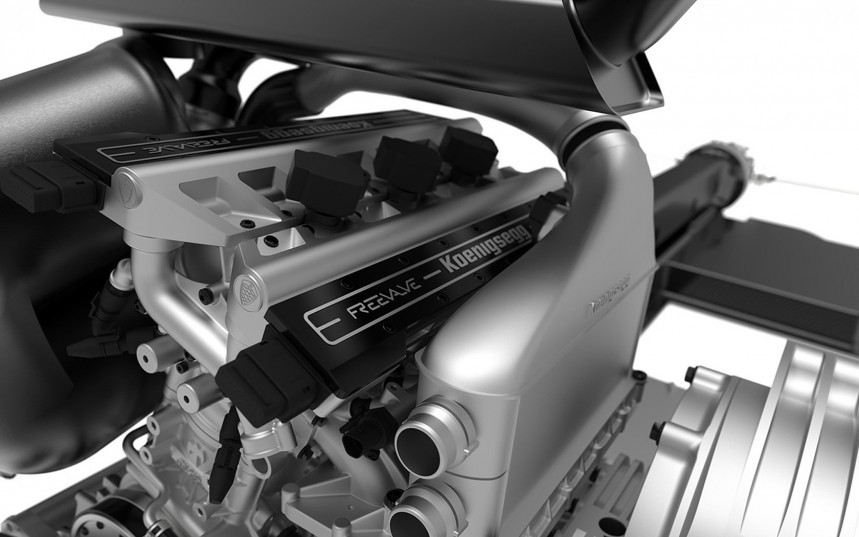Unveiled at an online-streamed event that replaced the canceled 2020 Geneva Motor Show, the Koenigsegg Gemera is the Swedish manufacturer’s first production four-seater and the first to use a compact engine along with a tri-motor setup, on an all-wheel-drive hybrid powertrain.
It is called the Tiny Friendly Giant for obvious reasons; the 2.0-liter inline-three twin-turbo is small, especially when compared to the engines at the heart of its Agera and Jeko siblings, but for what it lacks in size, it delivers in terms of power.
It is environmentally friendly because it can run on ethanol-based fuels, utilizes a cylinder deactivation system that reduces consumption, and works together with three electrical motors that can take control and exclusively power the car for up 50 kilometers (31 miles).
The power output of the small, mid-mounted engine is gigantic, as it produces 608 PS (447 kW; 600 hp) and 600 Nm (443 lb.-ft.) of torque.
Along with the three motors and with the TFG fed with E85 fuel, the Gemera’s hybrid powertrain can reach 1,700 PS (1,250 kW; 1,677 hp) and 3,500 Nm (2,582 lb.-ft.) of torque.
Koenigsegg claims that the Gemera can reach a top speed of 400 kph (249 mph) and it can accelerate from 0-100 kph (62 mph) in 1.9 seconds using the combined power of the TFG and the three electric motors.
Those are overwhelming figures that are quite ordinary for Koenigsegg, which has gotten us used to some of the most powerful production cars out there.
This engine is so unusual and innovative that it stands in a league of its own. The TFG has enormous boreholes and an exceptionally long piston stroke, but despite that, it is capable of revving to 8500rpm.
The second most powerful inline-three out there being Toyota GR Yaris’ 268 hp 1.6-liter G16E-GTS engine that produces 272 PS (268 hp).
Another atypical feature of this engine is the absence of a camshaft. Instead, it uses Koenigsegg’s Freevalve technology developed with help from SparkCognition, the world’s leading AI company.
It uses pneumatic actuators to independently open and close each valve, allowing the engine to run at high power and efficiency at the same time.
Also, the system can deactivate cylinders by using the Frequency Modulated Torque technology to further reduce consumption by 15-20%, compared to an engine with direct injection and a variable camshaft.
The TFG’s Freevalve technology solves an age-old problem of traditional combustion engines that give out most of their exhaust pollutants during the first twenty seconds of a cold start, due to cold cylinders and catalytic converters.
By heating up and circulating the fuel mixture back and forth through the intake and exhaust valves, the engine reduces cold-start emissions by 60% compared to an equal-sized traditional engine with camshafts.
This system gave Koenigsegg engineers the opportunity to develop a patent-pending simplified two-stage turbo system.
Each turbo is connected to one of the exhaust valves of each cylinder. When the engine runs at lower rpm’s all exhaust gasses are directed to a single turbo by only opening one exhaust valve per cylinder and increasing the gases that go to that turbine.
When more power is needed, the Freevalve system opens the other exhaust valve, and the second turbo kicks in.
The engine does not just offer extreme performance in a small, lightweight package, it also sounds incredible. The deep roar that comes out of the custom Akrapovic titanium exhaust is guaranteed to give anyone goosebumps.
The innovations behind the Tiny Friendly Giant’s immense output revolutionize the combustion engine and gives us hope that it will not go extinct too soon.
The Koenigsegg Gemera will hit the streets next year but the production is going to be limited to 300 units and in order to get one, enthusiasts must consider the eye-watering starting price of $1.7 million.
It is environmentally friendly because it can run on ethanol-based fuels, utilizes a cylinder deactivation system that reduces consumption, and works together with three electrical motors that can take control and exclusively power the car for up 50 kilometers (31 miles).
The power output of the small, mid-mounted engine is gigantic, as it produces 608 PS (447 kW; 600 hp) and 600 Nm (443 lb.-ft.) of torque.
Koenigsegg claims that the Gemera can reach a top speed of 400 kph (249 mph) and it can accelerate from 0-100 kph (62 mph) in 1.9 seconds using the combined power of the TFG and the three electric motors.
Those are overwhelming figures that are quite ordinary for Koenigsegg, which has gotten us used to some of the most powerful production cars out there.
This engine is so unusual and innovative that it stands in a league of its own. The TFG has enormous boreholes and an exceptionally long piston stroke, but despite that, it is capable of revving to 8500rpm.
The second most powerful inline-three out there being Toyota GR Yaris’ 268 hp 1.6-liter G16E-GTS engine that produces 272 PS (268 hp).
Another atypical feature of this engine is the absence of a camshaft. Instead, it uses Koenigsegg’s Freevalve technology developed with help from SparkCognition, the world’s leading AI company.
Also, the system can deactivate cylinders by using the Frequency Modulated Torque technology to further reduce consumption by 15-20%, compared to an engine with direct injection and a variable camshaft.
The TFG’s Freevalve technology solves an age-old problem of traditional combustion engines that give out most of their exhaust pollutants during the first twenty seconds of a cold start, due to cold cylinders and catalytic converters.
By heating up and circulating the fuel mixture back and forth through the intake and exhaust valves, the engine reduces cold-start emissions by 60% compared to an equal-sized traditional engine with camshafts.
This system gave Koenigsegg engineers the opportunity to develop a patent-pending simplified two-stage turbo system.
Each turbo is connected to one of the exhaust valves of each cylinder. When the engine runs at lower rpm’s all exhaust gasses are directed to a single turbo by only opening one exhaust valve per cylinder and increasing the gases that go to that turbine.
When more power is needed, the Freevalve system opens the other exhaust valve, and the second turbo kicks in.
The innovations behind the Tiny Friendly Giant’s immense output revolutionize the combustion engine and gives us hope that it will not go extinct too soon.
The Koenigsegg Gemera will hit the streets next year but the production is going to be limited to 300 units and in order to get one, enthusiasts must consider the eye-watering starting price of $1.7 million.












